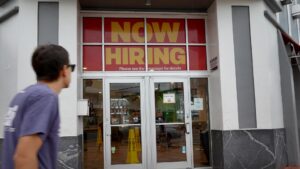Strong Job Growth: Implications for the Economy and Fed Policies
As the economy continually evolves, the latest labor market data indicates robust job growth, presenting both opportunities and challenges for investors and policymakers. December’s job report, released by the Bureau of Labor Statistics, showcased nonfarm payrolls soaring by an impressive 256,000 jobs, significantly surpassing the Dow Jones consensus estimate of 155,000. The December figures illustrated not only a considerable jump from the 212,000 reported for November but also an overall strong job performance heading into 2024.
The Unemployment Rate and Its Significance
The unemployment rate edged down to 4.1%, slightly better than expected. Importantly, an alternative measure that includes discouraged workers and those involuntarily working part-time fell to 7.5%, marking the lowest level since June 2024. This decline in the unemployment rate signals a strong labor market and can influence everything from consumer spending to inflation rates.
However, the implications of this data extend beyond just the unemployment figures. The response from financial markets was immediate—stock futures dropped, and Treasury yields surged as traders recalibrated expectations around potential interest rate cuts this year. According to Dan North, senior economist at Allianz Trade, the overall strong performance in the labor market "relieves" some pressure on the Federal Reserve, making the case for rate cuts less pressing amidst an ongoing stagnation in inflation rates.
Wage Growth: A Double-Edged Sword
On a positive note for workers, average hourly earnings increased by 0.3% in December, which aligns with forecasts. However, the year-on-year wage growth rate of 3.9%, while still a gain, is a reminder that wage inflation appears to be stabilizing. This could ease concerns that rapid wage increases will drive overall inflation and complicate the Fed’s policy decisions.
Though wage growth is a significant factor for consumer sentiment and spending—a critical component of economic vitality—recent data suggests it may not be enough to spur the Fed into action on rate cuts. As noted by Ellen Zentner, chief economic strategist at Morgan Stanley, the ongoing labor market strength likely means "the Fed will maintain a hawkish stance."
Sector Performance: Understanding the Drivers of Job Growth
Job creation in December was driven largely by sectors we’ve come to expect:
- Healthcare added 46,000 jobs
- Leisure and Hospitality came in strong with 43,000
- Government positions rose by 33,000
Retail saw a rebound as well, marking a 43,000 job gain after a temporary loss in November, showcasing a resilient consumer sentiment heading into the holiday shopping season.
However, a look back at 2023 reveals a contrasting story for the retail sector, which saw a total payroll growth of only 2.2 million compared to a robust 3 million in 2022. This shift serves as a reminder that while job growth remains strong, it is essential to keep an eye on trends over longer periods.
The Path Ahead: Fed’s Dilemma
With December marking the close of a year characterized by varying job growth and an ongoing debate about potential recession risks, the Fed faces a compelling challenge. The recent reports suggest a market likely to expect a hold on interest rates at the upcoming meeting—with the probability of only one rate cut for 2024 rising to 68.5% after this latest jobs data.
As we turn our eyes to upcoming inflation data, market participants are advised to remain vigilant. Central bankers are acutely aware of the persistent inflation driven by high housing costs and rising prices of goods. These conditions could further complicate decisions around monetary policy.
At Extreme Investor Network, we believe that deepening your understanding of labor market dynamics is essential for making informed investment decisions. Tracking these trends enables investors to identify opportunities while remaining aware of potential economic shifts. As we navigate through 2024, staying engaged with labor market changes will be crucial for maximizing investment potential.
Conclusion
In summary, the December job report signals a resilient labor market, filled with opportunities yet intertwined with challenges, as inflation remains a key concern for the Fed. Understanding the full economic landscape is critical for investors, and here at Extreme Investor Network, we’re committed to keeping you informed with unique insights and analysis that can help guide your investment strategies in these changing times. Stay tuned for more updates as we decode the intricate interplay between employment data and broader economic implications.

